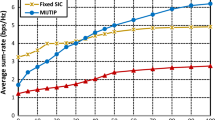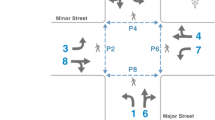Abstract
This paper presents a methodology for the coordination of multiple robotic agents moving from one location to another in an environment embedded with a network of agents, placed at strategic locations such as intersections. These intersection agents, communicate with robotic agents and also with each other to route robots in a way as to minimize the congestion, thus resulting in the continuous flow of robot traffic. A robot’s path to its destination is computed by the network (in this paper, ‘Network’ refers to the collection of ‘Network agents’ operating at the intersections) in terms of the next waypoints to reach. The intersection agents are capable of identifying robots in their proximity based on signal strength. An intersection agent controls the flow of agent traffic around it with the help of the data it collects from the messages received from the robots and other surrounding intersection agents. The congestion of traffic is reduced using a two-layered hierarchical strategy. The primary layer operates at the intersection to reduce the time delay of robots crossing them. The secondary layer maintains coordination between intersection agents and routes traffic such that delay is reduced through effective load balancing. The objective at the primary level, to reduce congestion at the intersection, is achieved through assigning priorities to pathways leading to the intersection based on the robot traffic density. At the secondary level, the load balancing of robots over multiple intersections is achieved through coordination between intersection agents by communication of robot densities in different pathways. Extensive comparisons show the performance gain of the current method over existing ones. Theoretical analysis apart from simulation show the advantages of load-balanced traffic flow over uncoordinated allotment of robotic agents to pathways. Transferring the burden of coordination to the network releases more computational power for the robots to engage in critical assistive activities.
Similar content being viewed by others
References
Li Q, DeRosa M, Rus D (2003) Distributed algorithms for guiding navigation across a sensor network. In: Proceedings of the 2nd international workshop on information processing in sensor networks
Batalin M, Sukhatme GS, Hattig M, Robot M (2004) Navigation using a sensor network. In: Proceedings of the IEEE international conference on robotics and automation
Corke P, Peterson R, Rus D (2005) Localization and navigation assisted by cooperating networked sensors and robots. Int J Robot Res 24(9): 771–786
Dresner K, Stone P (2004) Multiagent traffic management: a reservation-based intersection control mechanism. In: Proceedings of the third international joint conference on autonomous agents and multiagent systems
Dresner K, Stone P (2005) Multiagent traffic management: an improved intersection control mechanism. In: Proceedings of the fourth international joint conference on autonomous agents and multiagent systems
Bazzan ALC (2005) A distributed approach for coordination of traffic signal agents. Autono Agents Multi-Agent Syst 10(2): 131–164
Roozemond DA (1999) Using intelligent agents for urban traffic control control systems. In: Proceedings of the international conference on artificial intelligence in transportation systems and science, pp 69–79
Trail Research School, Architecture of an Agent Based Urban Intersection Control System, Report (1999)
Bennewitz M, Burgard W, Thrun S (2002) Finding and optimizing solvable priority schemes for decoupled path planning techniques for teams of mobile robots. Robot Auton Syst 41(2): 89–99
LaValle S, Kuffner J (2001) Randomized kinodynamic planning. Int J Robot Res 20(5): 378–400
Sveska P, Overmars M (1995) Coordinated motion planning for multiple car-like robots using probabilistic roadmaps. In: Proceedings of the IEEE international conference on robotics and automation
Madhava Krishna K, Hexmoor H, Chellappa S (2005) Reactive navigation of multiple moving agents by collaborative resolution of conflicts. J Robot Syst 22(5): 249–269
Minguez J, Montano L (2004) Nearness diagram (ND) navigation: collision avoidance in troublesome scenarios. IEEE Trans Robot Autom 20(1): 45–59
Borenstein J, Koren Y (1989) Real-time obstacle avoidance for fast mobile robots. IEEE Trans Syst Man Cybernet 19(5): 1179–1187
Latombe J-C (1991) Robot motion planning. Kluwer Academic, Dordrecht
Author information
Authors and Affiliations
Corresponding author
Rights and permissions
About this article
Cite this article
Viswanath, D.V.K., Madhava Krishna, K. Towards load-balanced de-congested multi-robotic agent traffic control by coordinated control at intersections. Intel Serv Robotics 2, 81–93 (2009). https://doi.org/10.1007/s11370-009-0035-x
Received:
Accepted:
Published:
Issue Date:
DOI: https://doi.org/10.1007/s11370-009-0035-x




